|
|
The Funbook 1 workshops were the first Let’s Read Math workshops and everyone wanted to contribute new ideas for improving and expanding the lessons. You will have fun thinking of ways to modify your workshops. For example:
For the Quilts workshop, we ended up using two different books about quilts, with activities that required two full sessions.
The Funbook lesson for Amelia Bedelia (involving combinatorics) is quite accessible to all, but beware that the recommended workshop got very involved as it was used not only in elementary grades, but on into middle school, high school and even college!
If you like to have food at your workshop, consider the Grandfather Tang workshop. Everyone likes to do the Chinese tangram puzzles, but they definitely enjoyed eating Chinese food at the end of the workshop. They learned how to use chopsticks and interpret messages in fortune cookies.
For each workshop listed below, read the workshop description. Then download the workshop outline to help you get organized for the workshop. (Remember that the FUNbook lesson for Amelia Bedelia is straightforward, but you may want to skip the more complicated WORKshop lesson. We opted to include the Workshop directions … if you are up to the challenge.)
|
|
 |
1. Alexander Who Used to Be Rich Last Sunday, by Judith Viorst
The book: Alexander has trouble saving money. Grandma and Grandpa come to visit and Alexander gets a dollar. Bit by bit it disappears. Did he really spend a whole dollar? What are some strategies you can use for saving money?
The math activity: Guess how much money is in the jar. Spill out all the coins and count them up, counting by 1s, 5s, 10s and 25s. Make a piggy bank and start to save your own money. Count out $1 in coins to start your savings.
Take-home item: A piggy bank of some kind – purchased or handmade. |
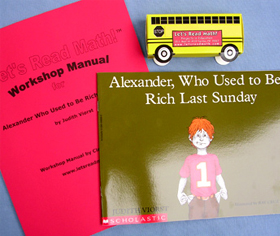
|
|
|
 |
2. Amelia Bedelia, by Peggy Parish
The book: Amelia Bedelia is a maid who gets things pretty mixed up. Is she having trouble learning English perhaps? For example, one thing she does is “dress a chicken”… with clothes! How many outfits does the chicken have? This question is used to launch a lesson in combinatorics.
The math activity: This workshop requires the use of a Funbook, because children start by punching out clothes for the chicken. Then they punch out different clothes to make outfits for a pig! The workshop focuses on the use of tree diagrams as a way to count combinations. The finale is to have the chicken and pig share their clothes! (Lots of combinations!)
|
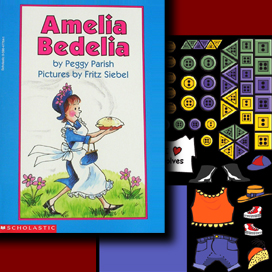
|
| Take-home item: Use this workshop to introduce the Funbook. The Funbook itself becomes the take-home item. There is a visual discrimination game on the inside back cover, where children have to find a chicken and pig who are wearing the exact same outfit- shoes, pants, top, and hat! |
|
|
 |
3. Grandfather Tang’s Story, by Ann Tompert
The book: A tangram is an ancient Chinese puzzle using the same seven pieces to form different shapes. In this tranquil book, a Chinese grandfather tells his granddaughter a fairy tale, using the tangram shapes to create the animals in the story.
The math activity: Learn how to fold and cut the tangram shapes from a square piece of paper. Then develop spatial sense by making the tangram designs in the book…or by creating your own!
Take-home item: A set of tangrams with diagrams of some sample puzzles to try at home. |
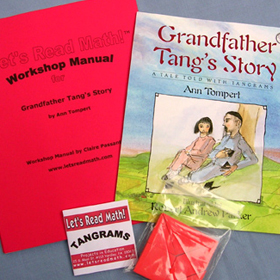
|
|
|
 |
4. The Greedy Triangle, by Marilyn Burns
The book: The little triangle is happy with the important jobs he has – holding up bridges, making music in a symphony orchestra, making sailboats, etc. But he yearns to have just ONE more side, and ONE more angle. The magic shapeshifter turns him into a square, then a pentagon, a hexagon. Finally, he has so many sides he can hardly stand up! Was it a good idea for him to want to be different?
The math activity: Talk about 2D and 3D geometry as you form polygons, pyramids and prisms using marshmallows and toothpicks!
Take-home item: Take home the marshmallow constructions made in the workshop. Cut and fold 3D shapes |
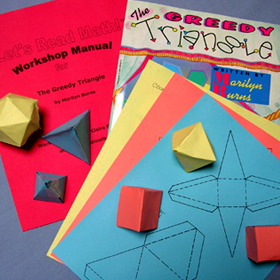
|
|
|
 |
5. How Big Is a Foot? by Rolf Myller
The book: The carpenter’s apprentice, a tiny man, is asked to make a bed as a
birthday present for the queen. The king, a big man, used his foot to measure a good size for the bed, 3 feet by 6 feet. But when the apprentice makes the bed, it is too small. What went wrong?
The math activity: Trace your feet and make a graph. Act out the story of the king who wants to make a bed for the queen. Later, have fun using rulers, yardsticks and tape measures to measure things. If one is available, use a trundle wheel to measure longer distances.
Take-home item: An "interesting" one-foot ruler, or a tape measure. |
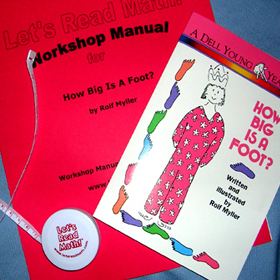
|
|
|
 |
6. The King’s Commissioners, by Aileen Friedman
The book: The king had too many commissioners. Someone should count them. The king and his advisors start counting. One advisor counts by 2s; another advisor counts by 5s. The princess uses tens and ones. Who is right?
The math activity: Use a hundreds chart to see patterns that emerge when you count in different ways, and to develop number sense. Then make froot loop necklaces using counting patterns.
Take-home item: A paper hundreds chart in a plastic sleeve, or awhiteboard with a hundreds chart on it. Also a small marking pen for finding patterns or performing computations on the chart. |
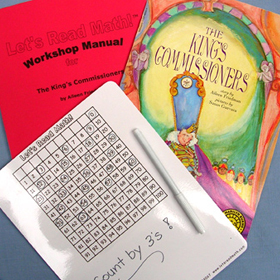
|
|
|
 |
7. Sam Johnson and the Blue Ribbon Quilt by Lisa Campbell Ernst
The book: Sam Johnson loves to quilt, but the ladies’ quilting group won’t let him join! What do |
you think about that?! [Use another book, Eight Hands Round by Ann Whitford Paul, to see samples of quilt designs.]
The math activity: Study geometric transformations by making paper quilt squares and seeing how they look as you slide them or turn them. How do they look as "flips" or reflections? Use one mirror to find lines of symmetry. Then make two mirrors into a folding mirror, to see reflected designs and to experiment with angles of reflection.
Take-home item: Two small acrylic mirrors to explore reflected shapes. |
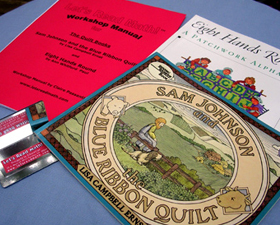
|
|
|
 |